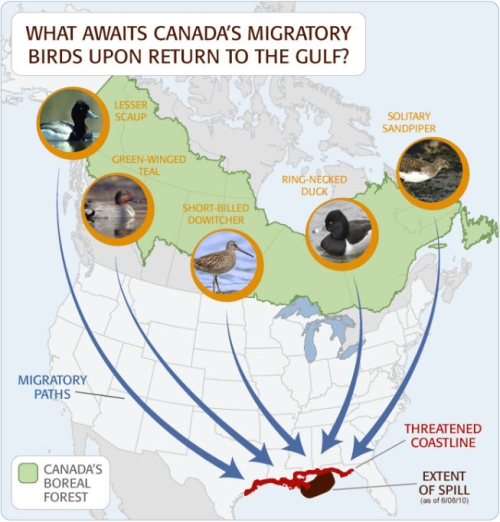
Photo Courtesy of Boreal Songbird Initiative
Seattle, WA – Millions of Canada’s migratory birds, representing more than a hundred species, could be at risk when they return this fall to areas in the Gulf of Mexico affected by the oil spill. The Gulf Coast serves as important habitat for hundreds of Canada’s bird species which use the region for wintering grounds and migratory stopover habitat.
“The world’s largest migration occurs every year when billions of birds fly from Canada to areas south, including the Gulf Coast,” said Dr. Jeff Wells, senior scientist at the Boreal Songbird Initiative. “We’re not sure what these birds will face when they return to areas hit by the oil spill, but certainly a large number of birds could be vulnerable to illness or even death.”
The migratory birds of Canada’s Boreal Forest represent a significant percentage of the birds that winter in the Gulf Coast region or stop during their travels further south. Canada’s Boreal Forest is the world’s largest intact forest and is home to more than 300 bird species, including 80 percent of North American waterfowl species, 63 percent of finches and 53 percent of warblers.
“There’s been a lot of attention to oil spill effects on local resident species,” said Wells. “But there’s a lurking time bomb for many waterfowl and shorebirds that breed in Canada’s Boreal Forest and winter or stop in the Gulf.”
Nearly 5 billion of Canada’s migratory birds fly south every fall, Wells adds. He and other experts worry these birds could face both long- and short-term adverse effects to shoreline habitat, necessary winter food sources and health.
The Gulf Coast is vitally important for many wetland bird species. The marshes, beaches and tidal flats provide ideal nesting areas and habitat for millions of waterfowl, seabirds, shorebirds and other water birds. These habitats also house fish, mollusks and other marine life that provide the food supply for many of these birds. The impact on smaller food sources like plankton could have a ripple effect on the entire food chain. There may also be longer-term effects stemming from physiological impacts of ingested oil that could lead to lower breeding success rates.
Currently, nesting birds such as terns, gulls and pelicans are hit hardest by the oil spill. Louisiana’s coast supports an estimated 77 percent of the U.S. breeding population of Sandwich Tern, 52 percent of Forster’s Tern and 44 percent of black skimmer. Many of North America’s most at-risk species also live in the region during a portion of the year, including Yellow Rail, Black Rail, Snowy Plover, Piping Plover, and Short-billed Dowitcher. The oil spill could pose long-term implications for the health of their total populations.
“We’ve really only seen the tip of the iceberg so far,” said Wells. “Species from the Boreal and other areas may encounter habitats and food sources contaminated with oil on their journey south that may cause illness or even mortality. These birds, and the generations to come after them, are endangered by the oil spill’s impact to critical marsh and beach habitat.”
While there isn’t much that can be done to mitigate effects of the oil spill on wildlife, he adds, there are ways to protect bird populations in the future through prevention of habitat loss and fragmentation—one of the leading causes of declining bird populations worldwide.
“By protecting intact ecosystems such as the 1.4 billion acres of Canada’s Boreal Forest,” said Wells, “we can give these critical populations of migratory birds a fighting chance of recovering from devastating occurrences such as the Gulf oil spill.”
The following video is an informational piece from Ducks Unlimited.
Click here to donate to the Boreal Songbird Initiative!
Interviews and Additional Information:
Jeff Wells, Boreal Songbird Initiative, 207.458.8492 mobile, jeffwells@borealbirds.org
About the Boreal Songbird Initiative:
Dr. Jeff Wells is the Science and Policy Director for the Boreal Songbird Initiative (BSI). BSI is a non-profit organization dedicated to outreach and education about the importance of Canada’s Boreal Forest to North America’s birds.









Comments on this entry are closed.
We will be feeling the effects of the spill for decades to come! It may not be visible and the media may no longer cover it, but it is still there and still causing harm to people and animals who frequent the area.
.-= sciencedude288´s last blog ..Fire! 7-19-10—79F—96H—TFI =-.
It’s such a shame that this will hurt southbound migrating birds.
.-= John´s last blog ..Dead Birds Found on a Louisiana Island =-.